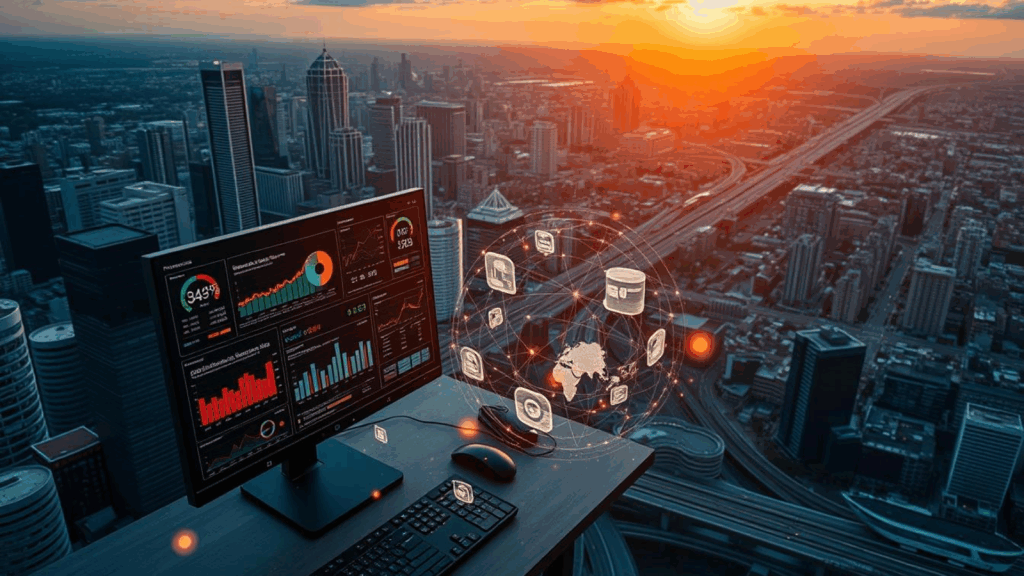In the realm of real estate, digital twins create virtual versions of physical buildings. They use digital twins real estate technology to merge information from diverse sources. These include sensors, IoT devices, and integrated building systems. This results in dynamic and current simulations of properties.
This advanced virtual model does more than show a building’s layout. It captures the complex interactions of systems within and around the building. With updates from real data, property managers can observe, run hypothetical situations, and improve decision-making. In essence, digital twins offer innovative approaches for visualization, simulating possibilities, and managing properties more effectively in the real estate technology sphere.
Key Takeaways
- Digital twins create virtual models of physical properties.
- They integrate data from sensors and IoT devices.
- Real-time simulations help monitor and manage buildings.
- Digital twins enhance decision-making in property management.
- This technology is a part of smart building solutions.
Cost-saving potential through real-time asset monitoring
In the domain of virtual modeling in real estate, digital twins have become pivotal. They play a crucial role in slashing operational costs by monitoring assets in real time. Operational expenses often include hefty maintenance and utility bills. By integrating real-time data from HVAC, lighting, and security into digital twins, businesses can tackle maintenance proactively, optimizing operations.
This forward-thinking strategy in virtual modeling in real estate prevents costly repairs and premature system replacements. Moreover, it significantly boosts energy efficiency across property portfolios. Employing IoT in real estate means systems are under constant watch. This allows any problems to be fixed swiftly, preventing potential damage and dodging extra expenses that come from neglect and system breakdowns.
Additionally, real-time asset monitoring through digital twins gives deep insights into real estate data analytics. This approach helps property managers grasp consumption trends and pinpoint areas where costs can be cut. By harnessing IoT in real estate insights, stakeholders are empowered. They’re able to make smarter decisions, pushing further towards cost effectiveness and elevated asset performance.
Using digital twins to meet compliance and maintenance goals
Compliance and maintenance play crucial roles in property management. Digital twins offer a seamless way to meet these objectives. They compile real-time data to promptly signal any deviations. This enhances efficiency in managing properties.
Digital twins transform property management by providing a precise method to adhere to regulations. They allow for detailed tracking and easy visualization of information. This reduces the need for manual checks. Property managers can quickly tackle compliance or maintenance issues, thanks to real-time alerts.
Furthermore, digital twins enhance transparency and streamline documentation. This makes it easier for property managers to prepare for audits. Efficient tracking and documentation highlight the benefits of digital transformation in this field. It helps companies consistently meet high standards.
How to integrate digital twins into your property workflows
Integrating digital twins into property management workflows marks a major advancement in digital transformation in property management. It starts by identifying essential data. This includes environmental impacts, system efficiency, and patterns of tenant use. This crucial data lays the groundwork for precise digital twins.
For real-time data capture, it is crucial to incorporate real estate technology like IoT sensors. These devices monitor everything from climate control to security systems. Analyzing this real-time data offers insights. These insights guide decisions in upkeep, safety, and managing efficiently.
Digital twins need to be tuned to trigger alerts and compile reports from this data. These functions predict system breakdowns, refine resource allocation, and improve tenant satisfaction. Ensuring staff understand new digital practices and the ongoing input from digital twins is vital.
Digital workflow establishment and adapting to constant feedback require thorough staff education and revisiting company protocols. Integrating smart building solutions with current operations maintains proactive property management.
Understanding successful integration involves these key steps:
- Identifying essential data covering environment, system functionality, and tenant activity.
- Utilizing IoT sensors and devices for up-to-the-minute data gathering.
- Analyzing fresh data for actionable intelligence.
- Adjusting digital twins for key data surveillance, alerting, and reporting.
- Updating staff training and practices to meld digital workflows seamlessly.
To successfully integrate digital twins, a detailed plan is indispensable. This ensures technological upgrades substantially benefit property management. The aim is to employ advancements in real estate technology and smart building solutions. This creates streamlined, effective, and forward-looking property management operations.
| Integration Step | Description |
|---|---|
| Data Source Identification | Pinpoint essential data types for thorough management. |
| Sensor Deployment | Set up IoT devices to collect data in real-time. |
| Data Analysis | Transform real-time data into actionable insights for wise decisions. |
| Twin Configuration | Configure digital twins to oversee and report critical data points. |
| Staff Training | Train team members to leverage new digital tools and workflows. |
Barriers to adoption and how to avoid them
Digital twins provide many advantages in property management, yet their adoption faces obstacles. High initial technology costs stand out as a major barrier. For many property managers, the substantial upfront investment required for smart building solutions and digital twin technology is off-putting. It’s crucial to emphasize the long-term financial benefits and efficiency improvements these technologies can yield.
Data security is another significant challenge. With digital twins relying on extensive data, its security becomes a top priority. Property managers must focus on strong cybersecurity measures. They should work diligently with technology providers to protect digital twin systems. Adopting best practices in data management is also key to mitigating these concerns.
The requirement for specialized skills forms another barrier. To incorporate digital twins into property management, there’s a need for personnel skilled in these technologies. Forming robust partnerships with technology providers can lead to effective training programs. These initiatives enable teams to adeptly manage and maximize the benefits of smart building solutions.
To persuade stakeholders, property managers need to craft a compelling argument. They should highlight the innovation and advantages that digital twins bring to property management. Showcasing the promise of long-term cost reductions, enhanced operational efficiency, and superior property performance can help secure the needed investments.
The future: combining digital twins with AI and automation
The real estate sector is on the brink of a revolution, thanks to the fusion of digital twins with AI and automation. This integration allows for the analysis of extensive data from digital twins. Such analysis enables accurate maintenance predictions and enhances building operations. It also brings about tailored environment controls for tenants, boosting their satisfaction.
Automation enhances these benefits by simplifying repetitive tasks. This reduction in manual tasks minimizes errors and gives property managers time for strategic planning. Through automation, real estate management becomes more efficient, encompassing real-time asset monitoring and optimizing energy use and space.
The success in leveraging digital twins in real estate depends on advanced AI and automation investment. Developing comprehensive integration strategies and keeping up with technology changes are essential. This approach ensures that real estate practices stay innovative, leading to superior management and tenant contentment.
FAQ
What are digital twins and how do they work in real estate?
Digital twins create virtual versions of physical real estate assets. They gather data from sensors, IoT devices, and systems, offering dynamic simulations. These simulations reflect both the building’s structure and its internal functions. This allows for real-time monitoring and scenario planning. As a result, property managers get a powerful tool for better decision-making in managing their assets effectively.
How do digital twins contribute to cost savings in real estate?
By providing real-time asset monitoring, digital twins cut operational costs significantly. They allow for smarter maintenance and system optimization, reducing the need for costly repairs and replacements. Thus, they not only save money but also enhance energy efficiency. Additionally, catching issues early prevents further damage, lowering expenses linked to maintenance delays and failures.
How can digital twins help meet compliance and maintenance goals?
Digital twins streamline compliance and maintenance for property managers. They track real-time data, instantly highlighting any variances from standards or schedules. This automatic monitoring ensures buildings stay within regulations and maintenance is timely, supporting easier compliance documentation and standard maintenance.
How can property managers integrate digital twins into their current workflows?
To incorporate digital twins, property managers should start by setting up IoT sensors and analyzing garnered data for actionable insights. They need to define which data is critical for thorough management. Following this, digital twins should be configured to supervise this data, creating alerts for maintenance and management decisions. Staff training and workflow adjustments are required to adapt to digital processes and real-time data insights.
What barriers might property managers face when adopting digital twins, and how can they overcome them?
The adoption of digital twins faces challenges like high costs, data security issues, and the need for extra skills. Managers can tackle these by partnering with tech providers, emphasizing training, and focusing on data security. Highlighting the long-term benefits and efficiency gains helps make a case for investing in digital twin technology.
What does the future hold for digital twins in real estate?
Digital twins are set to evolve with AI and automation, improving their utility. AI can predict maintenance needs and customize tenant environments, enhancing satisfaction. Meanwhile, automation will make routine operations more efficient, allowing managers to target strategic goals. Investing in AI and refining integration strategies remains key for future advancements in real estate management.






